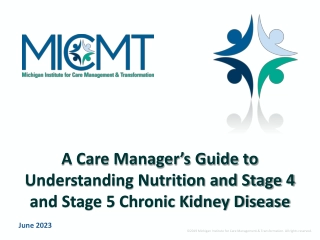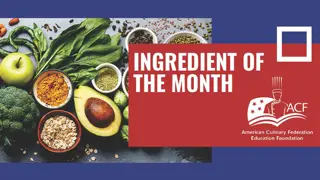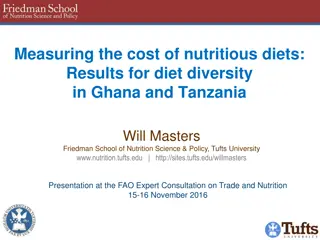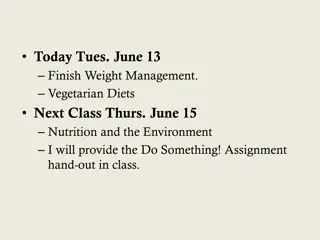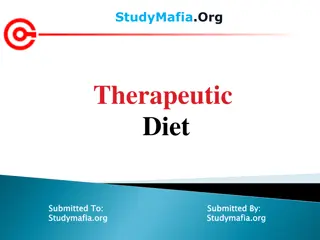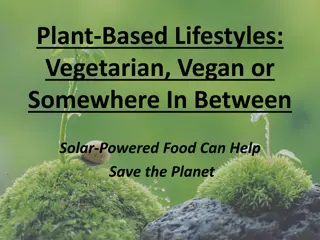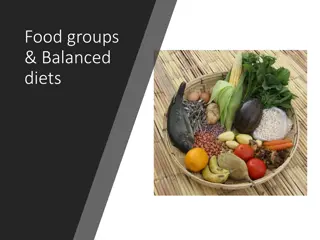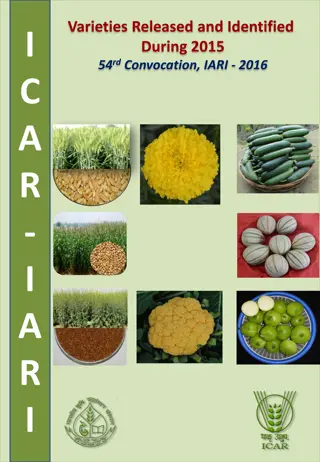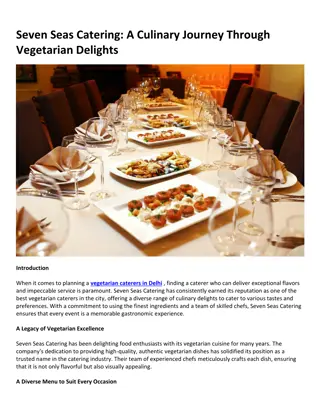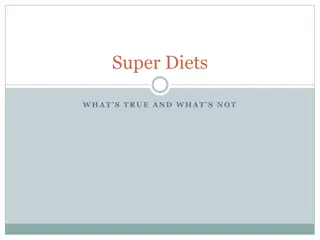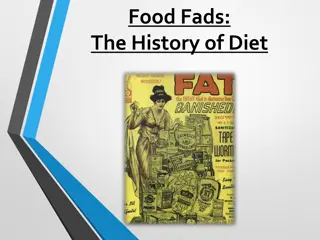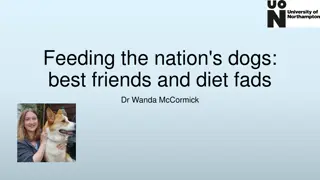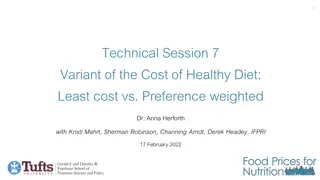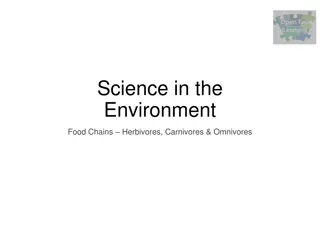Understanding Vegetarian Diets: Benefits and Varieties
Discover the different types of vegetarian diets, health benefits, reasons to choose a vegetarian lifestyle, and insights into weight loss considerations. Learn how plant-based diets can improve heart health, lower diabetes risk, and explore the importance of making healthy food choices within a vegetarian framework.
Download Presentation

Please find below an Image/Link to download the presentation.
The content on the website is provided AS IS for your information and personal use only. It may not be sold, licensed, or shared on other websites without obtaining consent from the author. Download presentation by click this link. If you encounter any issues during the download, it is possible that the publisher has removed the file from their server.
E N D
Presentation Transcript
V is for Vegan/Vegetarian Jolene Wolf, MPH, RD, LD, CDE Clinical Dietitian Mary Greeley Medical Center
Vegetarian Diets Continue to Increase in Popularity 3% of Americans are full-time vegetarians 37% say they always or sometimes eat vegetarian when dining out 20% are likely to look for a restaurant which serves some vegetarian items
What is a vegetarian diet? Lacto-vegetarian excludes meat, fish, poultry, eggs; includes dairy Ovo-vegetarian excludes meat, fish, poultry, dairy; includes eggs Lacto-ovo vegetarian excludes meat, fish, poultry;includes dairy, eggs Pescatarian excludes meat, poultry, dairy, eggs; includes fish Vegan excludes meat, poultry, fish, eggs, dairy, honey Flexitarian a semivegetarian diet; primarily plant-based but includes animal products on occasion or in small amounts
Why choose a vegetarian diet? Health benefits Weight loss Religious/moral/ethical reasons Environmental motivation
Health Benefits Top reason for choosing vegetarian Heart health Healthier plant-based foods=25% lower chance of heart disease Unhealthy plant foods=32% higher chance of heart disease Diabetes Healthy plant foods diet=34% decreased risk of diabetes Less healthy plant food diet=16% higher risk of diabetes Eating more healthy plant foods while NOT cutting out meat still has benefits for heart health and for avoiding diabetes.
Twinkie Vegetarian Vegan/vegetarian diets are NOT automatically healthy Limit refined carbs Emphasize whole grains, whole fruits/vegetables and nuts
Weight Loss Vegetarian diets don t automatically result in weight loss Tend to be lower in calories and higher in fiber=feel full on less cals Replacing meat with cheese and nuts could even increase calories Many vegetarians avoid alcohol, caffeine, & tobacco and exercise regularly-helps control weight
Cancer Risk Processed meat How you cook your meat AICR promotes a plant based diet Phytochemicals Pooled data from 2 Oxford studies showed fish eaters had a lower risk of certain cancers than vegetarians Studies comparing caner rates in vegetarians and nonvegetarians have shown inconsistent results
Other Vegetarian Health Factors Study in JAMA suggests a vegetarian diet may be just as effective as statin drugs in lowering cholesterol Was low fat Included soy, nuts, margarines with plant sterols, high fiber grains, plenty of fruits and vegetables
Are there downsides to vegetarian diets? Mood problems? No cause and effect link to mental problems and vegetarian diets Hair loss? Meat contains protein, iron, vitamin B and zinc-all important for hair growth
How to Follow a Vegetarian Diet Choose a variety of healthy plant-based foods Whole fruits and vegetables Legumes and nuts Whole grains Cut back on less healthy choices Sugar sweetened beverages Fruit juices Refined grains
Healthy Vegetarian Eating Pattern (servings for a 2000 cal/day diet) Vegetables Dark green Red and orange Legumes Starchy Other 2-1/2 cups a day 1-1/2 cups a week 5-1/2 cups a week 1-1/2 cups a week 5 cups a week 4 cups a week
Grains 6-1/2 ounces a day Whole grains >3-1/2 ounces a day Refined grains <3 ounces a day
Protein foods Eggs Legumes Soy products Nuts and seeds 3-1/2 ounces a day 3 ounces a week 6 cups a week 7 ounces a week 8 ounces a week
Fruits Dairy Added sugars, solid fats, added refined starches 2 cups a day 3 cups a day No more than 290 calories a day (15% of total calories)
Oils 27 grams a day
Challenging Nutrients The more restrictive the diet, the more challenging to get all the nutrients needed Vegan diets eliminate natural food sources of B12 Vegan diets eliminate dairy which contains calcium Pay special attention to the following nutrients: Calcium, vitamin D Vitamin B-12 Protein Omega-3 fatty acids Iron, zinc, iodine
Calcium and Vitamin D Calcium helps build/maintain strong teeth and bones Milk and dairy foods are highest in calcium Dark green vegetables are good plant sources Calcium-enriched and fortified products are other options Vitamin D also plays a role in bone health Vitamin D is added to cow s milk, some brands of soy and rice milk, and some cereals and margarines Check food labels Low fortified food intake and limited sun exposure=may need plant derived vitamin D supplement
Vitamin B-12 Necessary to produce red blood cells and prevent anemia Found almost exclusively in animal products May go undetected because high folate masks deficiency till severe problems occur Vegans should consider: B-12 supplements Enriched cereals Fortified soy products
Protein Helps maintain healthy skin, bones, muscles, organs Eggs and dairy are good sources Plant foods provide sufficient protein if you eat a variety through day Soy products and meat substitutes Legumes Lentils Nuts Seeds Whole grains
Omega-3 Fatty Acids Important for heart health Diets low in fish and eggs are low in active forms of Omega-3 Fas Canola and soy oils, walnuts, ground flaxseed, soybeans are good sources of essential Fas Conversion of plant-based Omega-3 is inefficient Vegans should consider fortified products, supplements, or both
Iron Iron is a crucial component of RBCs Sources include legumes, lentils, enriched cereals, whole grains, dark leafy greens, dried fruits Not as easily absorbed from plant sources Recommended intake for vegetarians almost double that of non-vegetarians To aid absorption, eat foods rich in vitamin C at the same time Strawberries, citrus, tomatoes, cabbage and broccoli
Zinc Essential component of many enzymes Plays a role in cell division And formation of proteins Not as easily absorbed from plant sources Cheese is a good option if you eat dairy Plant sources include whole grains, soy, legumes, nuts, wheat germ
Iodine Component in thyroid hormones Help regulate metabolism, growth and function of key organs Vegans may not get enough May be at risk of deficiency and goiter Foods such as soybeans, cruciferous vegetables and sweet potatoes may promote a goiter teaspoon of iodized salt per day provides a significant amount of iodine
Common Questions Do I have to start over totally? Will changes cost me more? Will this take more time? Why do I have to do this?
Tips for Introducing Vegetarian Food Into Institutions Easiest way to meet needs of different categories of customers is to offer vegan menu items Start with minor changes to existing menu Changes should be easy to implement Begin with changes that do not involve excessive staff time/training or equipment purchases Cost of new menu items should be equal to or less than existing Potential cost savings of vegetarian options can be a selling point to administrators
Simple Modifications to an Existing Menu Examine the existing menu Are there already vegetarian items? Baked potatoes Salads Breads Soup (no chicken or beef broth) Mac and cheese/meatless lasagna/pizza Indicate by a special marking on the menu, an info card at POS, or by posting a separate vegetarian menu
Simple Modifications to an Existing Menu Make a vegetarian soup a daily menu item Offer a meatless prepared salad (bean or grain) every day Consider adding a salad bar Offer cooked pasta or a baked potato every day If a selection of hot entrees is offered each day, make one of them meatless Have nondairy milks available Keep a good supply of fresh fruit available at all times
Simple Modification of Existing Recipes Many soups can be made vegetarian by changing from meat-based stock to a vegetable stock. Replace meat stock with vegetable stock in pilaf, other grain dishes, sauces Lasagna can be prepared with a meatless sauce with vegetable subs When preparing spaghetti or pasta sauce, prepare part w/o meat Use vegetable oil instead of animal fat for frying/saut ing Prepare or purchase baked goods with vegetable instead of animal fat
Simple Modifications of Existing Recipes Prepare or purchase yeast breads without eggs or dairy Milk can be replaced with soy milk, rice milk, or with water in most recipes Buttermilk can be replaced with soured soy milk or rice milk (use 1 cup soy milk plus 1 Tbsp of vinegar) Crumbled tofu can be substituted for cottage cheese or ricotta cheese in recipes Offer vegetarian beans, chili beans, refried beans w/o lard
Simple Modifications of Existing Recipes Over 60 varieties of nonmeat burger patties exist to sub for hamburgers Vegetarian hot dogs are also available To produce a chewier, meatier tofu, freeze it for 3 days, thaw, squeeze out water, and crumble Add bulgur to the beans in tacos, chili, etc. if you want less beans See handout for more tips
Typical Entrees with Vegetarian Alternatives Chicken fajitas/Tofu fajitas (use Lawry s Fajita Seasoning) Beef or chicken tacos/Bean or Bean and Nut-Seed tacos Spaghetti with meat sauce/Spaghetti with marinara sauce Lean beef or chicken patty on bun/ADM Burger patties (dry mix) Chicken gyros with Tzatziki sauce in pita/ADM taco filling in pita with sauce Ground beef or turkey lasagna/lasagna with meatless sauce Stromboli sandwich with turkey, ham, mozzarella/Vegetable Stromboli sandwich with mozzarella, sliced tomato, sliced black olives Beef and cheese egg rolls/La Choy vegetable egg rolls with almonds (these are vegan)
Breakfast Substitutions Eggs scrambled tofu Crumble tofu, add spices, turmeric or curry for color Pancakes Use soy milk or water in place of dairy milk If you eliminate eggs, increase the baking powder and add lemon jc or vinegar French Toast blend soy milk and banana to use as dipping batter Cold Cereal Hot Cereal
Breakfast Substitutions Polenta Fry on a griddle, serve with applesauce Juices Bread Be sure ingredients don t list animal fat If catering to vegans, no eggs, whey, casein or other dairy products Bagels serve with jam or bananas instead of cream cheese Fresh fruit
Quantity Recipes Vegan in Volume by Nancy Berkhoff https://www.vrg.org/catalog/index.php?main_page =product_info&cPath=1&products_id=10
Fast, Lower Budget Vegan Menu Items Three-Bean Tamale Pie Alternate three types of cooked beans with salsa, top with prepared vegan cornbread mix, and bake. Optionally, substitute mashed potatoes for the cornbread.
Chili Saut Add chopped bell peppers, onions, and garlic to three or four bean chili and saut or bake. Serve over steamed rice, vegetarian cornbread, or mashed potatoes.
Veggie Shepherds Pie Top vegetable stew a mix of carrots, celery, onions, and mushrooms or mixed vegetables combined with cooked beans with prepared mashed potatoes and bake.
Pasta Bake Combine cooked pasta with tomato sauce, chopped tomatoes, and diced mushrooms. Season with ground basil and oregano and bake.
Lentil Stew Combine cooked lentils with cooked, quartered steamed potatoes; cooked carrot slices; diced celery; and chopped tomatoes. Season with pepper and dill, and simmer until ready to serve.
Veggie-Size Serve veggie burgers topped with vegetarian chili and chopped veggies. Serve on a hamburger bun or toasted bread.
Burrito Wrap Fill a large tortilla with mashed beans, sliced chilies, chopped tomatoes or salsa, and sliced onions. Heat in the oven or microwave and serve hot.
References Mayoclinic.org Webmd.com Vrg.org Eatright.org Health.Harvard.edu MD Anderson Cancer Center Dietary Guidelines for Americans


